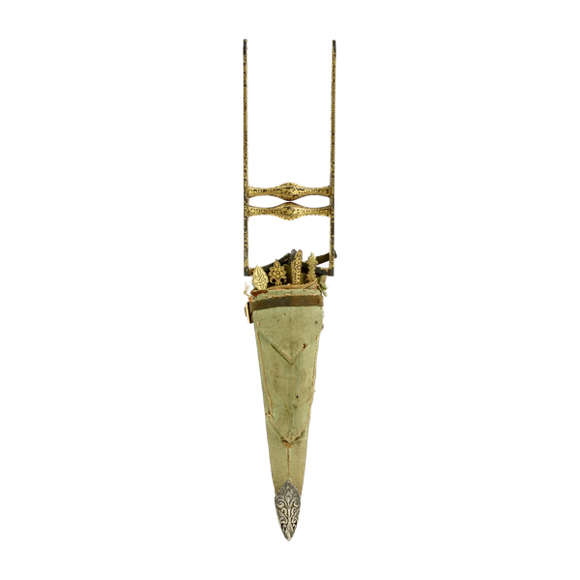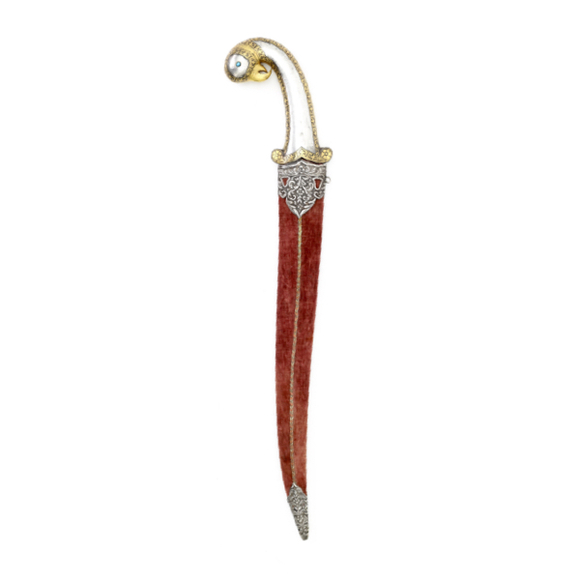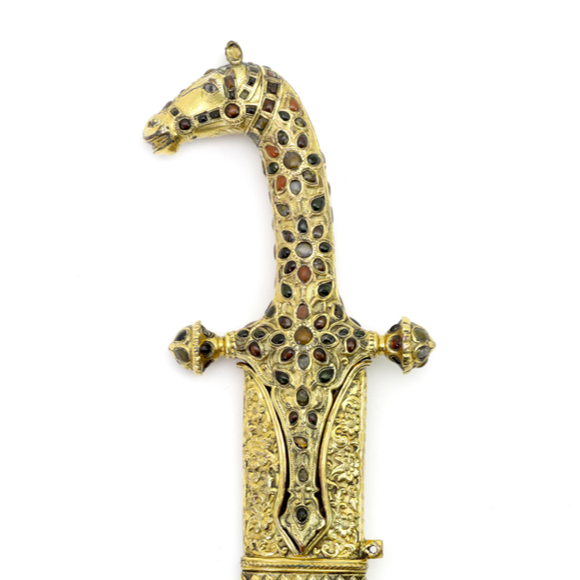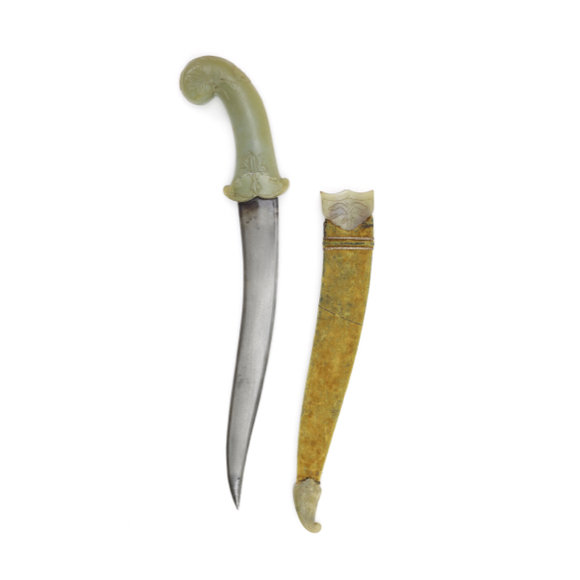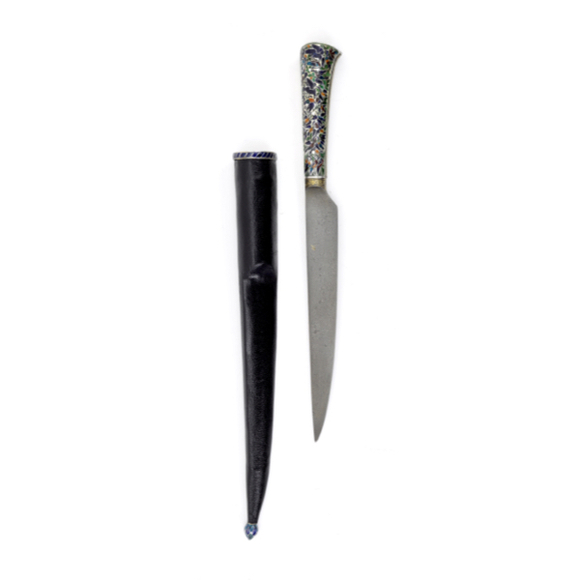With a fine wootz blade with a pronounced center ridge.

36.9 cm
23.9 cm
Base 4 mm
Middle 4 mm
Reinforced tip 7 mm
Base 51 mm
Middle 38 mm
Reinforced tip 26 mm
373 grams
2 cm from hilt
Iron, steel, wood, silk velvet, silver, gold
Probably Bundi, Rajasthan
Mid 19th century
From the Ravinder Reddy collection
Description
An interesting and unusual north Indian dagger that stylistically is related to the jambiya.
It features a wide, curved blade with a central ridge and reinforced tip. The blade is entirely made of fine pattern-welded steel. The base of the blade is chiseled on either side with an elephant head and stylized lilies.
The elephants are positioned in a way that they are always positioned upright when the dagger is observed with the hilt on the right side while the blade is pointing left.
Hilt
The all-steel hilt is riveted to the base of the blade. Its form reminds of jambiya, chilanum and so-called "tiger tooth daggers", but holds its own stylistically. It is decorated with gold koftgari overlay in typical north Indian fashion. The large amount of exposed steel in the design suggests that it is a precious steel, like wootz, but its pattern now rendered invisible by a deep dark patina that I did not feel like disturbing to find out.
There is a screw at the pommel that when unscrewed allows removal of the pommel plate, showing a hollow hilt that could be used for storing things.
Scabbard
It comes with its original scabbard with a wooden core, covered in bright green silk velvet. The mountings are fine pierced silver, worked in repousse, depicting flowers, and floral elements. Under the domed profile at the scabbard mouthpiece are lillies much like those chiseled on the blade.
Condition
In good condition. Hilt with deep, dark but stable patina. Blade in more recent polish to reveal its fine steel. Scabbard in good condition. One small section of silver at the chape was lost, I had a silversmith replace it. Scabbard velvet with the usual wear and discoloration. There is some minor play in the hilt/blade junction.
Attribution
Its always hard to date and attribute the unusual, but this dagger presents us with some hints as to where it might be from. The style and execution of the lillies is seen most notably katar daggers from Jeypore, Bundi and Delhi so that in itself doesn't tell us much other than it being of northern Indian make.1
The elephant however, is less common and strongly associated with Bundi. A piece that immediately come to mind is a katar from Bundi in the Metropolitan Museum, accession number 36.25.912:

This example bears an inscription in Harauti, written in Devanagari script:
"Bundijaram, Lord of Bundi, will protect with this dagger,
[for], when it pierces, is like the tongue of death."
The other side has a Vikram Samvat date of 1909, which converts to 1852 A.D.
What is interesting about this katar is not only the presence of a chiseled elephant in similar style, but also its alignment on both sides. Like on our dagger, it is only upright when the dagger is viewed with the hilt on the right side and the blade pointing left. Or, from the wielder's point of view, only properly aligns when held in the right hand.
Bundi is known for its Hathi Pol; "Gate of the Elephants", one of the city gates that features two large facing elepants.
A katar very similar to the Metropolitan Museum example is published in a catalog accompanying the 1883 Jeypore exposition, it is the second from the left:
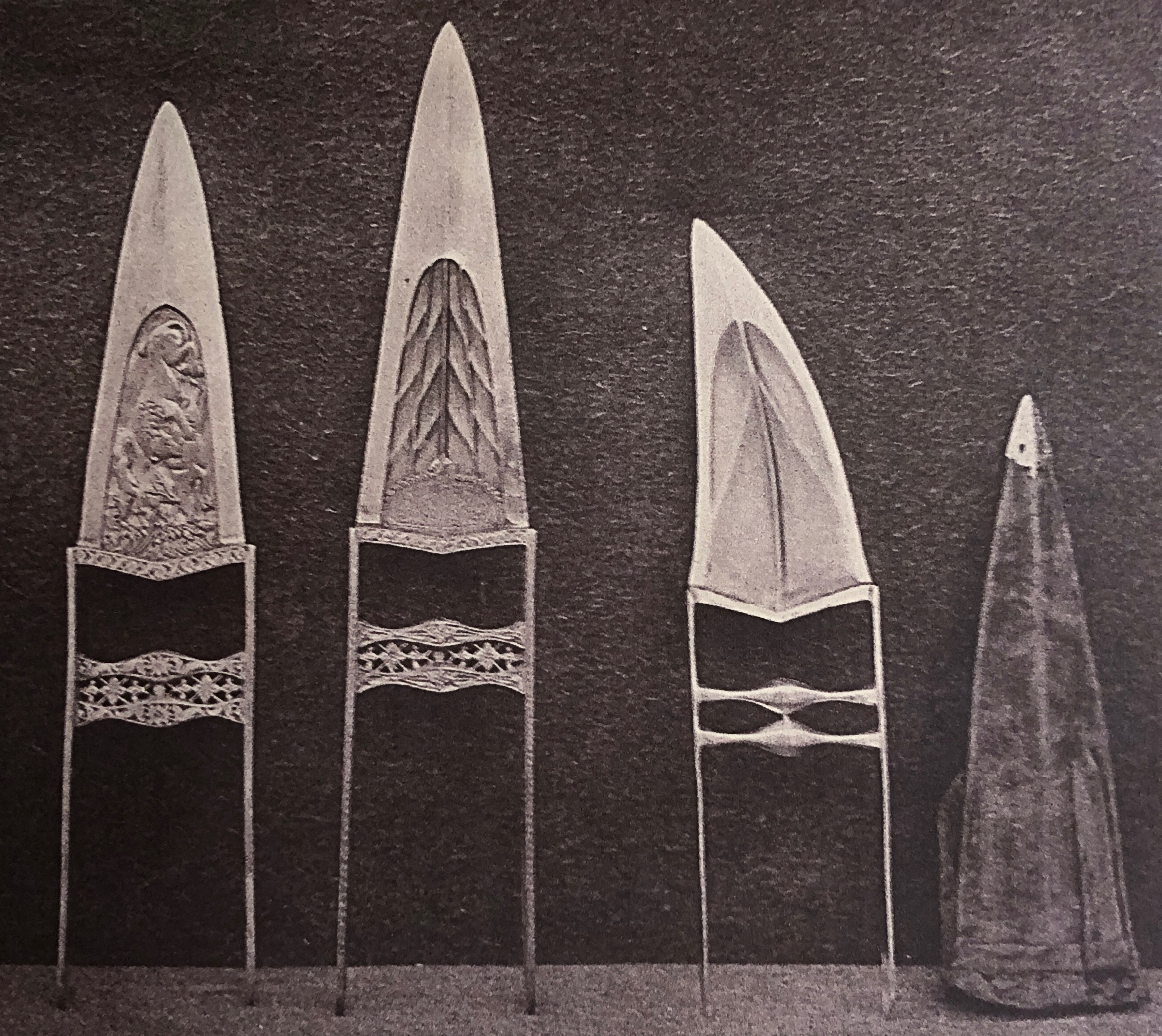
"Steel dagger, Katár. Blade long, with three high ridges and numerous lateral ones. Gilt guards and double bars united by open work, the whole decorated with a floral pattern. On one side is an inscription in gold to the effect that the dagger was the property of Mahárájá Rám Singh, of Búndi. Made by Khema, armourer." 2
Khēmau (खेमौ) was active as an armorer at Bundi from at least 1836 to 1872.3
Conclusion
A most unusual dagger, generally following the form of a jambiya but much more Indian in execution than most. It features a chiseled elephant on the forte that suggests it may have been made in Bundi, a town mostly known for its production of ornate katar. The blade is nicely made, of quality pattern welded steel. The scabbard may be one of the best parts about this piece, with fine silver mounts.
Notes
1. Thomas Holbein Hendley; Damascening on steel or iron as practiced in India. W. Griggs & Sons, Ltd. London 1892.
2. Thomas Holbein Hendley; Memorials of the Jeypore Exhibition, Vol. 1: Industrial art. W. Griggs & Son Ltd. London. Plate XXI.
3. See glossary article: Khēmau (खेमौ).




























The style typical of Kutch, the execution far above what is normally seen on work from that area.
Nice and complete with opaque green hilt and scabbard mounts.
With designs of animals, often attributed to Lucknow, north India.

